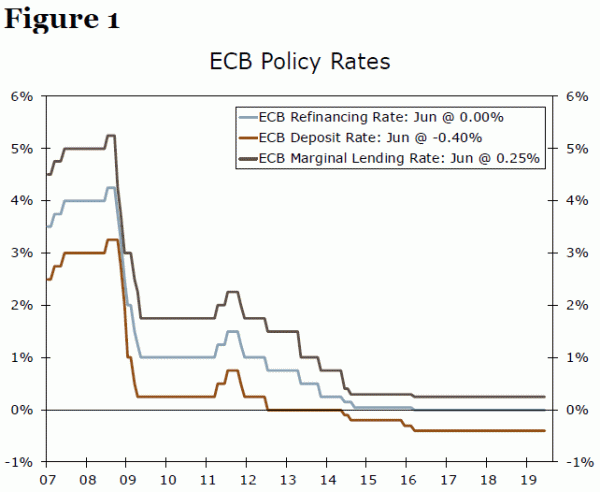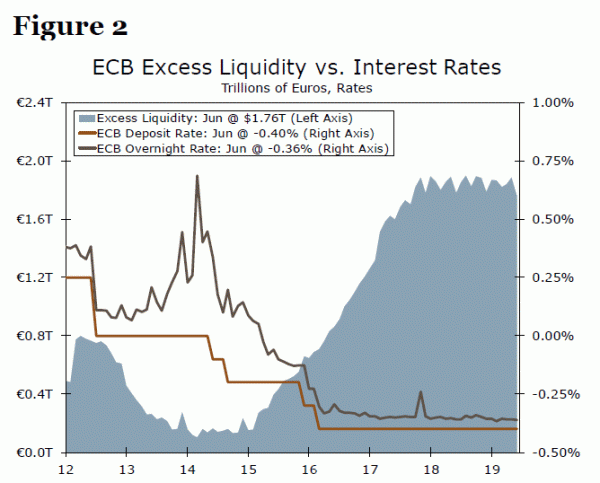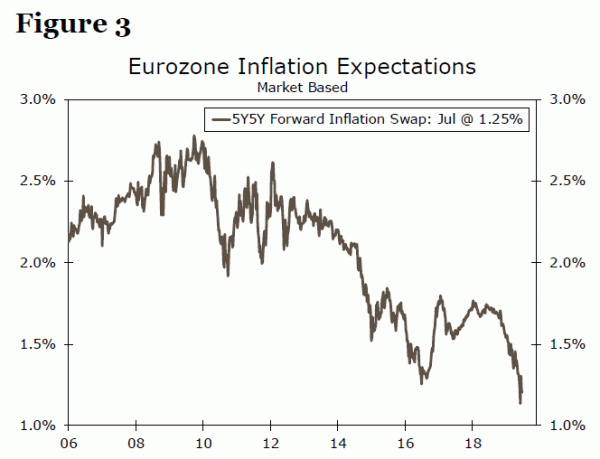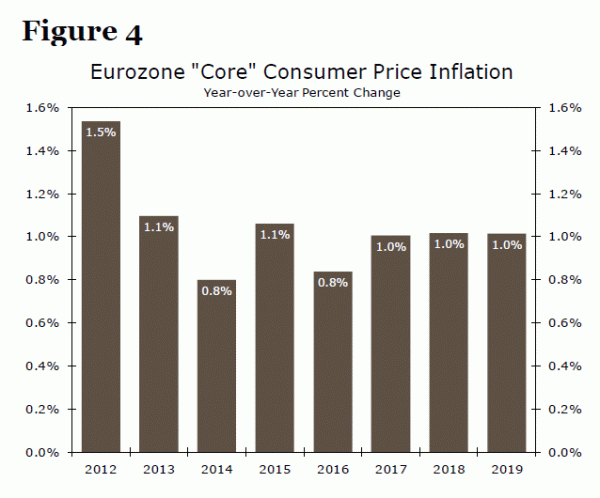Executive Summary
- ECB policy uncertainty has risen substantially as the central bank mulls easing policy and as markets contemplate how the appointment of Christine Lagarde to replace ECB President Draghi will affect policy.
- Lagarde’s lack of experience in central banking makes it hard to ascertain her policy stance. We suspect she will lean heavily on ECB staff members and newly-appointed Chief Economist Philip Lane, at least early in her term. Overall, we do not think her appointment is a game changer for ECB monetary policy, and instead see continuity.
- In that regard, we still expect one 10 bps rate cut from the ECB at its September meeting, to be signaled at the upcoming July meeting. However, we acknowledge that in recent weeks, the risk of additional policy easing, including further or sooner rate cuts and QE, have risen.
The Changing of Lagarde
The underwhelming performance of the Eurozone economy has been characterized by sluggish GDP growth and stubbornly low inflation, which remains well short of the central bank’s target goal of “close to, but below” 2%. It is against that backdrop that European Central Bank (ECB) President Draghi delivered dovish comments in mid-June, suggesting that additional stimulus measures would be required absent an improvement in the economic data. He also repeatedly suggested that the ECB is prepared to use all of its tools to stimulate Eurozone growth. Amid lingering uncertainty in the region and subdued growth, we expect the ECB to cut its deposit rate and main refinancing rate 10 bps to -0.50% and -0.10%, respectively, in September. However, we do not expect further rate cuts or renewed quantitative easing (QE) at this time, although we acknowledge that the risk of additional easing has increased in recent weeks.
One potential source of uncertainty around that outlook is a change in leadership atop the ECB, with former International Monetary Fund (IMF) head, Christine Lagarde, having been nominated to take over for Mario Draghi as ECB president in November. At this time Lagarde’s stance on monetary policy is unclear, and we likely will not have a better understanding of her policy objectives until well into her tenure. However, our assumption is that Lagarde will not meaningfully change the course of ECB monetary policy, and will likely rely heavily on her fellow policymakers and the broader ECB staff early on in her term as ECB president.
In particular, one of the key figures she will likely rely on is newly appointed ECB Chief Economist Philip Lane. In a recent speech, Lane stated that without its non-standard measures such as quantitative easing (QE) and forward guidance, inflation and growth would be considerably lower, suggesting an overall supportive stance on a wide range of policy easing measures.1 With those comments in mind, we suspect Lane to be a key voice in support of an accommodative policy stance once Lagarde takes the helm. Still, the key challenge facing the ECB at present – stimulating the Eurozone economy with limited monetary policy capacity – will likely remain prevalent as Lagarde takes the reins.
What to Expect at the July Meeting
We currently expect the ECB to cut its deposit and refinancing rates 10 bps at the September meeting to -0.50% and -0.10%, respectively. When the central bank meets next week, we expect it will revise its forward guidance to signal that September rate cut. At its June meeting, the ECB said that interest rates would remain “at their present levels at least through the first half of 2020.” We expect the central bank to change that language in its statement next week such that it signals rates will remain “at present levels or lower for an extended period of time.” This would be consistent with past periods in which it has signaled near-term interest rate reductions.
As highlighted by Philip Lane in his most recent speech, the deposit rate plays a primary role in anchoring short-term interest rates in the Eurozone, and thus we have a relatively high degree of conviction that the ECB will adjust the deposit rate in September (Figure 2).2 What about the main refinancing rate? Main refinancing operations were one of the ECB’s primary tools for adjusting monetary policy prior to the global financial crisis, but given the increase in excess liquidity in the Eurozone, the ECB has used this facility less to adjust policy. However, the main refinancing rate is important in the sense that it is used as a benchmark for the interest rates offered on the ECB’s targeted long-term refinancing operations (TLTROs).
TLTROs are a form of cheap financing for commercial banks, and are another element of the ECB’s overall toolkit of accommodative monetary policies. At its June meeting, the ECB revealed that these loans would be offered to commercial banks with a maturity of two years at an interest rate equal to the average main refinancing rate over the life of the operation, plus 10 basis points. For example, if the main refinancing rate were to be unchanged at its current level of 0.00% over the life of the operation, the commercial bank’s effective borrowing cost on the loan would be 0.10% (0.00% + 10 bps). However, if as we expect, the main refinancing rate is cut 10 bps to -0.10% and remains there over the life of the operation, the commercial bank’s effective borrowing cost would be 0.00% (-0.10% + 10 bps). In that sense, the ECB can offer additional accommodation by reducing the main refinancing rate as well as the deposit rate.3
The main risk around next week’s meeting, in our view, is that the ECB cuts rates immediately rather than waiting until September. The central bank could view this as a way to more powerfully reinforce its commitment to the inflation mandate, as a September cut is widely expected and may not send as strong a message as an immediate cut. However, we also see risks that the ECB might restart its program of large scale asset purchases, or QE.
Is the ECB Preparing for Quantitative Easing?
With interest rates already negative, the ECB has limited traditional tools at its disposal to implement additional stimulus measures. However, QE is a means through which the ECB could provide additional monetary policy accommodation. The central bank ended its last QE program in December 2018, but Draghi and other policy makers have suggested that there is considerable room for another round of QE. If the ECB decides to move ahead with another round of QE it likely will not formally announce it next week but perhaps in September or later.
There are obstacles to more QE, however. The first of which is the ECB’s issuer limits, designed to safeguard market functioning and prevent the ECB from becoming a dominant creditor of Eurozone governments. The issuer limits currently restrict the ECB from buying more than 33% of any country’s eligible stock of sovereign debt. In countries with a low stock of outstanding government debt, such as Germany and the Netherlands, the ECB is already within just a few percentage points of this 33% limit based on our calculations. Thus, if the ECB were to relaunch QE and purchase sovereign debt, it will likely need to raise the current issuer limit, perhaps to 50%. The central bank has suggested it would be willing and able to raise its issuer limits for sovereigns, although we note previous efforts from the ECB to change the parameters of QE have been met with political resistance. The ECB has also reportedly discussed a legal work-around which may allow it to exceed the current issuer limits without having to raise them.4 Thus, there appears to be means through which the ECB can restart purchases of sovereign bonds, but some of these methods may be difficult or unwieldy to implement.
In addition to sovereign bonds, there is also the possibility that the ECB will purchase other instruments such as corporate bonds and asset-backed securities, as it did in its last QE program. We see the purchases of those assets as much more feasible than the purchase of Eurozone equities, which would be a first for the ECB (although the Bank of Japan and Swiss National Bank have bought domestic equities) and could be more politically challenging and harder to implement than purchases of sovereign or corporate debt. In all, it seems the ECB has scope to restart QE and purchase a range of assets, but we think the bar is high to do so given the existing constraints and the possible challenges associated with restarting the program.
For now, we do not think current Eurozone economic conditions – namely the inflation outlook – justify renewed QE from the ECB. There has, understandably, been a great deal of focus on the weakness in market-based measures of inflation expectations, namely the 5Y5Y forward inflation swap that ECB officials have cited in the past (Figure 3).5 That measure has fallen sharply over the past few months and is trading just above all-time lows. However, other measures of inflation expectations, including those of households and professional forecasters, have been more stable. ECB officials have recently stressed the importance of looking at a wide range of measures of inflation expectations, suggesting the central bank is unlikely to put undue weight on the weakness in market-based inflation expectations, instead relying on a variety of measures.
Finally, we note that actual inflation outcomes have been fairly resilient, albeit low. Core CPI inflation has been stuck right at 1% for the past two years or so, and, while this is below the ECB’s target, it also has not yet shown signs of deteriorating or heading lower. In contrast, when the ECB first launched QE in 2015, core CPI inflation had been trending lower for years and averaged just 0.8% in 2014 (Figure 4). Thus, while we acknowledge the risk of renewed QE – as well as other further easing measures, including additional rate cuts – for now we do not think the economic outlook justifies such action.
Conclusion
With inflation well below the ECB’s target and growth continuing to underwhelm, we expect the central bank to signal a rate cut at its upcoming meeting next week and ultimately deliver the cut in September. For now, we expect just one rate cut, but we acknowledge that in recent weeks, the risk of additional policy easing has heightened. Given that interest rates in the Eurozone are already well into negative territory, if the ECB decides that more easing is warranted, it may choose to revert to using non-traditional methods such as introducing renewed Quantitative Easing. An earlier surprise rate cut at next week’s meeting is also possible, although we do not think economic conditions in the Eurozone currently justify such aggressive policy actions from the ECB.
1 Lane, Philip. “Monetary Policy and Below-Target Inflation.” July 2, 2019.
2 See Footnote 1.
3 The interest rate on TLTRO loans can be as low as the deposit rate, plus 10 bps, over the life of the loan, depending on banks’ lending activities – the more banks lend, the lower is the rate on the loans. Thus, lowering the deposit rate should also make the terms of TLTROs more accommodative.
4 Canepa, Francesco. “Loophole may clear ECB’s way to buying more state debt-sources.” June 26, 2019.
5 Coeuré, Benoît. “Inflation expectations and the conduct of monetary policy.” July 11, 2019.

















